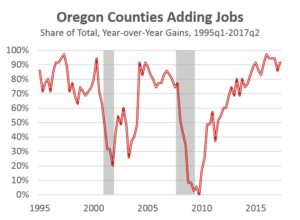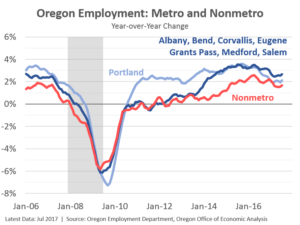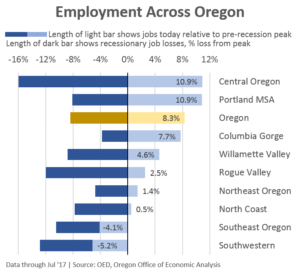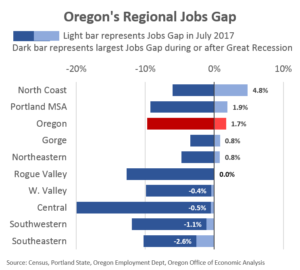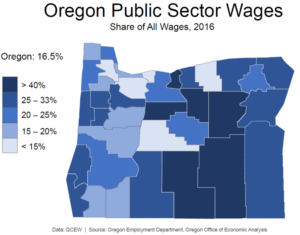Oregon’s Regional Recovery Gathers Steam
By Josh Lehner
Oregon Office of Economic Analysis
Just as Oregon’s economic expansion continues, so too does regional growth across the state. While half of the Oregon’s individual counties are currently at all-time highs for employment, nearly all have added jobs in the past year. Given regional variations, industrial mix, and noisy data, not once in the past 20+ years have each of Oregon’s 36 counties added jobs at the same time. In the second quarter 33 did add jobs over the past year, keeping with the typical pattern seen during expansions. Only Curry (barely), Morrow and Sherman counties lost jobs in the past 12 months.
Even as growth continues, it has slowed across most regions like it has statewide. This is particularly the case in the Portland region. Jobs are now being added at approximately a 2 percent pace throughout much of the metro area. This is the slowest growth the region has seen during an expansion in quite some time. Typically the Portland region sees 2% job growth when it is entering or exiting a recession. Job growth in recent months has picked up some in unrevised data, which is encouraging, if true.
Even as the state overall and the large urban areas have slowed, not every county has. Encouragingly a few of the hardest hit areas of the state are actually, finally seeing a pick-up in growth. These include some coastal, eastern, and southern communities. In particular Coos, Crook, Grant, Josephine, Klamath, Lake, Lincoln, and Wheeler counties are now adding jobs at a faster rate than in either 2015 or 2016. Except for Josephine (Grants Pass MSA), these regions of the state are not back to employment levels seen prior to the Great Recession, and some remain below late 1990s employment levels. However the trajectory of growth has improved considerably. The Southwestern, and Southeastern Oregon regional economies are now more than halfway back to where they were prior to the recession. All other regional economies within Oregon are back.
Of course looking just at the total number of jobs is an incomplete way to assess the economy. This was a point brought up during our most recent forecast release to the legislature. What really matters is whether there are enough jobs for everyone who wants one. And also whether there are enough willing workers for growing businesses. Our office uses a metric where we compare the actual job growth in a region of the state with what we estimate to be the growth in the potential labor force. This looks at population growth (or decline) and changes among demographic groups. For Southeast and Southwestern Oregon in particular their potential labor forces are smaller today than a decade ago. They have not seen much population growth, and a larger segment of their population has aged into their retirement years. As such, while their total employment remains 4-5% below pre-Great Recession levels, their employment gaps are smaller at 1 or 2%. Similarly, while Central Oregon’s employment is nearly 11% above pre-Great Recession levels, the region has just now caught up with population growth and effectively eliminated its jobs gap.
It is important to note that while many rural counties and regions do face demographic challenges and a shrinking working-age population, these demographic headwinds have pretty much played out. The demographic drag is done. Moving forward the vast majority of rural Oregon counties are expected to have increasing potential labor forces.
Finally, some of these job gains in rural Oregon are driven in part due to the local industrial structure and nature of the Great Recession. Many rural economies are more reliant upon housing and government than the larger, more diverse urban economies. It is not so much that rural areas love housing and government. Rather it is the rest of the private sector is smaller, thus making the public sector in particular a larger share. As the economy has continued to improve, migration flows have returned and public sector budgets are growing again, rural economies across Oregon have seen better growth. Even as the public sector remains a steady share over time in Oregon, that steady share varies in magnitude depending which part of the state we are looking at.
Disclaimer: Articles featured on Oregon Report are the creation, responsibility and opinion of the authoring individual or organization which is featured at the top of every article.

